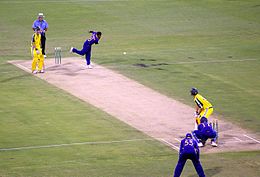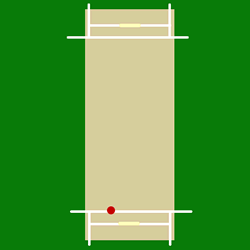Spin bowling
The bowlers with the highest, second-highest and fourth-highest number of wickets in the history of Test cricket, Muttiah Muralitharan, Shane Warne and Anil Kumble, respectively, were spinners.
This sort of spin means it is also possible for the Magnus effect to cause the ball to deviate sideways through the air, before it bounces.
[7] The combination of drift and spin can make the ball's trajectory complex, with a change of direction at the bounce.
Spin bowlers that open the bowling are rare, but became a more viable option with the introduction of Twenty20 cricket when pitch conditions are in their favour, and the ball also generally drifts more in the air.
The lower inherent momentum of a spin bowler necessitates more power exerted by the batsman to achieve the same results.
Therefore, spin bowling is more prevalent in the hot and humid conditions of the sub-continent as a form of energy conservation, especially in multi-day competitions.
In general, leg-spin is considered to be one of the toughest types of bowling in which to keep control of the ball, but it is very effective in picking off wickets.
[9] It is customary among cricket commentators to describe and judge the quality of spin bowling in terms of the characteristics flight, turn, bounce, drift, and dip.
For an offspinner, you will have to bowl from wide of off-stump to get the ball to turn into the right-handed batsman and force them to nick off the edge to a fielder or into the top of off stump.
A slow ball with extra flight may deceive the batsman into thinking it is slower than it is and therefore mistiming his shot.
Usually a spin bowler relies on tricks during flight to produce turn, bounce, drift and dip, or combinations of them.






